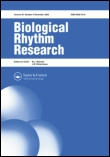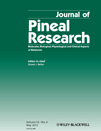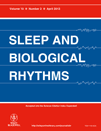
BIOLOGICAL RHYTHM RESEARCH
Scope & Guideline
Advancing Understanding: The Science of Biological Rhythms
Introduction
Aims and Scopes
- Circadian Rhythms and Biological Clocks:
Research exploring the mechanisms and implications of circadian rhythms, including how they influence sleep, metabolism, and behavior in various species. - Chrononutrition and Health:
Investigations into how timing of food intake interacts with biological rhythms, affecting health outcomes, metabolic disorders, and performance. - Seasonal and Environmental Influences:
Studies examining how seasonal changes and environmental factors (like light and temperature) affect biological rhythms and physiological responses in different species. - Chronotype and Individual Differences:
Research focusing on individual differences in chronotype (morningness-eveningness), their psychological and physiological impacts, and their associations with lifestyle factors. - Application in Clinical and Veterinary Settings:
Exploration of how biological rhythms can inform clinical practices, improve patient care, and enhance animal husbandry practices.
Trending and Emerging
- Impact of Social Jetlag:
An increasing body of research is focusing on social jetlag, particularly its effects on mental health, academic performance, and lifestyle behaviors in various populations, indicating a recognition of its significance in modern society. - Chronotype and Mental Health:
Studies linking chronotype with mental health outcomes, including depression and anxiety, are gaining traction, suggesting a deeper exploration of how circadian preferences influence psychological well-being. - Technological Advances in Monitoring Rhythms:
The integration of technology, such as wearable devices and novel software, for real-time monitoring of biological rhythms and sleep patterns is emerging as a prominent theme, enhancing data collection and analysis. - Chronotherapy and Personalized Medicine:
Research is increasingly examining the role of biological rhythms in chronotherapy, aiming to optimize treatment timings for various medical conditions based on individual circadian patterns. - Effects of Climate Change on Biological Rhythms:
There is a growing interest in how climate change and environmental stressors impact biological rhythms, particularly in agriculture and animal husbandry, highlighting the need for adaptive strategies.
Declining or Waning
- Historical Studies of Biological Rhythms:
There appears to be a waning interest in historical or classical studies focused solely on biological rhythms without contemporary applications or implications. - Basic Mechanistic Studies on Circadian Genes:
Research that solely focuses on the genetic and molecular mechanisms of circadian rhythms without connecting to broader physiological or behavioral outcomes has declined. - Studies Lacking Interdisciplinary Approaches:
Papers that do not incorporate interdisciplinary perspectives, such as psychology, nutrition, or environmental science, are becoming less common, as the field increasingly values integrated research. - Research on Non-Model Organisms:
There is a noted decrease in studies focusing on non-model organisms in favor of more widely studied species where research may yield quicker, more impactful results.
Similar Journals

JOURNAL OF PINEAL RESEARCH
Illuminating the Path of Endocrinology ResearchJOURNAL OF PINEAL RESEARCH, published by Wiley, is a leading peer-reviewed journal dedicated to advancing the field of endocrinology with a specific focus on the pineal gland and its significant roles in various physiological processes and disorders. Since its inception in 1984, the journal has established itself as a crucial platform for the dissemination of high-quality research, securing an impressive Q1 ranking in Endocrinology as of 2023, with Scopus rankings placing it among the top 5% of journals in the biochemistry, genetics, and molecular biology category. With an emphasis on original research articles, reviews, and letters in the areas of melatonin, circadian rhythms, and neuroendocrine regulation, the journal aims to foster interdisciplinary collaboration and knowledge-sharing among researchers, professionals, and students alike. Although not an open-access journal, its rigorous editorial process and wide-reaching impact factor ensure that published work reaches a global audience, making it an invaluable resource for those in the scientific community committed to the study of endocrinology and beyond.

Sleep Science
Connecting Scholars to Enhance Sleep Health WorldwideSleep Science is a premier open-access journal dedicated to advancing the understanding of sleep and its profound impact on health and well-being. Published by THIEME MEDICAL PUBL INC, this journal aims to bridge the gap between research and practice in the fields of Behavioral Neuroscience and Medicine. Since its inception in 2008, Sleep Science has become a vital resource for researchers, healthcare professionals, and students seeking to explore the intricate mechanisms of sleep, its disorders, and treatment methodologies. With a commitment to disseminating high-quality research, the journal features a diverse range of articles covering the latest findings in sleep studies. Notably ranked in the Q3 category in 2023 across Behavioral Neuroscience, Medicine, and Neuroscience (miscellaneous) in Scopus, it provides a platform for scholarly discourse and innovation. The journal's open-access model ensures that critical insights are available to a wide audience, thereby promoting collaborative efforts to improve sleep health globally. For more detailed information, visit 333 SEVENTH AVE, NEW YORK, NY 10001.

Nativa
Connecting researchers to enhance our natural resources.Nativa, published by the Universidade Federal de Mato Grosso in Brazil, stands as a prominent open-access journal since 2013, dedicated to the dissemination of research across various domains of Agricultural and Biological Sciences. With its ISSN 2318-7670, Nativa aims to foster scholarly communication and collaboration among researchers and practitioners worldwide. The journal occupies notable positions within the Scopus rankings, with a Q3 classification in several categories, including Agricultural and Biological Sciences (miscellaneous) and Environmental Science (miscellaneous), while also holding a Q4 classification in areas such as Agronomy and Crop Science and Animal Science and Zoology. This positioning reflects its commitment to advancing knowledge and understanding crucial to sustaining and enhancing our natural resources. Nativa seeks to engage a diverse readership by providing a platform for innovative research, fostering interdisciplinary discourse, and addressing pressing environmental challenges and conservation efforts essential for sustainable development.

PHYSIOLOGY & BEHAVIOR
Bridging the Gap Between Neuroscience and PsychologyPHYSIOLOGY & BEHAVIOR, published by Pergamon-Elsevier Science Ltd, is a premier journal that has been illuminating the intersections of physiological and behavioral research since its inception in 1966. With a promising impact reflected in its 2023 category quartiles— ranking Q2 in both Behavioral Neuroscience and Experimental and Cognitive Psychology, and a prior Q1 in Philosophy—this journal stands at the forefront of multidisciplinary research. It holds respectable ranks within the Scopus database, placing 27th out of 165 in Experimental Psychology and 25th out of 88 in Behavioral Neuroscience, highlighting its significant contribution to the academic community. The journal encourages the dissemination of high-quality research objectives that explore the intricate connections between behavior and biological processes, making it a vital resource for researchers, professionals, and students alike. Although access is not currently open, the journal continues to provide deep insights into crucial developments in its field, ensuring its readers stay updated on the latest scientific advancements.

Sleep and Biological Rhythms
Advancing Knowledge on Sleep's Role in Biological SystemsSleep and Biological Rhythms is a pivotal scholarly journal published by Springer Japan KK, focusing on the intricate relationships between sleep patterns and biological rhythms across various biological and psychological paradigms. Since its inception in 2003, this journal has consistently presented high-quality original research and comprehensive reviews that shed light on the multifaceted roles of sleep in health, disease, and behavioral science, making it an essential resource for researchers, professionals, and students in neurology, neuropsychology, and physiology. With an impact factor that places it in the Q3 quartile across several relevant categories, including neurology and physiological psychology, Sleep and Biological Rhythms provides critical insights that help advance our understanding of the physiological mechanisms underpinning sleep and circadian rhythms. While this journal offers a subscription-based model, its commitment to publishing rigorously peer-reviewed content ensures that it remains a trusted reference point for innovators and thought leaders in the fields of neuroscience and medicine. For more information, users are encouraged to access the journal through its dedicated page on the Springer website.

Journal of Obesity
Empowering researchers with open access to vital findings.The Journal of Obesity, published by HINDAWI LTD, stands at the forefront of research in the field of Endocrinology, Diabetes and Metabolism, providing a vital platform for the dissemination of knowledge and advancements in obesity research. With an impact factor that reflects its significance in the academic community—holding a prestigious Q2 ranking in its category—the journal has continuously evolved since its establishment as an Open Access publication in 2010, promoting unrestricted access to high-quality research. Operating from Egypt, the journal focuses on disseminating impactful studies that address the global epidemic of obesity, making a meaningful contribution to public health solutions. Researchers, professionals, and students in the related fields will find valuable insights and innovative findings within its pages, as the journal endeavors to bridge the gap between scientific research and practical application. As of 2023, it occupies a notable position, ranked #58 out of 244 in Scopus, showcasing its commitment to excellence and relevance in the rapidly evolving landscape of obesity research.

Journal of Physiological Sciences
Unlocking the Secrets of Physiological MechanismsThe Journal of Physiological Sciences, published by BMC, stands as a prominent platform for the advancement of research in the field of physiology. Based in Japan, this open-access journal (ISSN: 1880-6546, E-ISSN: 1880-6562) is committed to disseminating high-quality scientific articles that explore various facets of physiological functions and mechanisms. With a 2023 Scopus ranking placing it within the 41st percentile in the category of Physiology, it is recognized for contributing significant insights that bridge basic and applied physiological research. The journal maintains a Q2 quartile ranking within its category, highlighting its impact within the scientific community. Researchers, professionals, and students are encouraged to engage with cutting-edge studies published from 2006 to 2024, fostering an environment of knowledge accessibility and scientific collaboration. The journal not only serves as a vital resource for those involved in physiological research but also promotes broader understanding and application of physiological principles across various health and science sectors.

Biology of Sex Differences
Unraveling the Science Behind Sex DifferencesBiology of Sex Differences is an esteemed open access journal published by BMC that has been at the forefront of research since its inception in 2010. Focused on the intricate biological aspects of sex differences, this journal serves as a vital resource for researchers and professionals within the fields of Endocrinology and Gender Studies. With a remarkable impact factor and consistently high rankings—achieving Q1 status for both Endocrinology and Gender Studies in 2023—this journal is widely recognized for its contribution to advancing knowledge in these critical areas. The journal is based in the United Kingdom, reflecting its commitment to fostering global dialogue among scientists and scholars. With its open access model, Biology of Sex Differences ensures that cutting-edge research is accessible to a diverse audience, promoting collaboration and innovation. By encompassing a broad scope of topics related to the biological underpinnings of sex differences, this journal is essential for anyone looking to understand the complex interplay between biology and gender.

Journal of Comparative Physiology B-Biochemical Systems and Environmental Physiology
Illuminating the Complexities of Organisms and Their EnvironmentsJournal of Comparative Physiology B-Biochemical Systems and Environmental Physiology, published by SPRINGER HEIDELBERG in Germany, stands at the forefront of research in the fields of physiology, biochemistry, and ecological systems. With a commitment to fostering interdisciplinary communication, this journal has been a vital resource since its inception in 1974, converging scientific exploration through the lens of biochemical mechanisms and environmental adaptations in animal systems. Renowned for its rigorous peer-review process, it has achieved impressive rankings, including Q2 in Animal Science and Zoology and Ecology, Evolution, Behavior and Systematics, reflecting its substantial impact within these disciplines. The journal aims to disseminate cutting-edge research that advances our understanding of physiological and biochemical processes while addressing contemporary environmental challenges. While currently operating on a traditional access model, the journal's contributions are crucial for researchers, professionals, and students seeking profound insights into the complex interactions between organisms and their environments.

International Journal of Endocrinology and Metabolism
Exploring Innovations in Endocrinology and MetabolismThe International Journal of Endocrinology and Metabolism is a leading peer-reviewed publication dedicated to advancing knowledge and research in the fields of endocrinology, diabetes, and metabolism. Published by BRIEFLAND in the Netherlands, this journal features original research, comprehensive reviews, and insightful clinical studies that explore the multifaceted aspects of hormonal disorders and metabolic conditions. With an impact factor that places it in the Q3 quartile category for 2023, the journal serves as a critical resource for academics and practitioners aiming to stay at the forefront of this dynamic field. Spanning from 2010 to 2024, the journal offers an enriching platform for innovative ideas and practices, fostering collaboration among scholars and healthcare professionals alike. Although not open access, the content is meticulously curated to ensure high-quality scientific discourse, positioning the International Journal of Endocrinology and Metabolism as an essential reference for those dedicated to improving health outcomes related to endocrine and metabolic disorders.